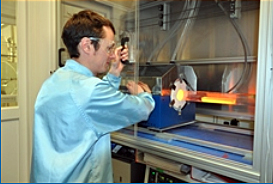23 Dec 2014
Academic-industrial partnerships to receive millions in "functional materials" R&D programs.
Significant new photonics-related research projects are among 10 national R&D programs announced on December 19 by the UK’s Engineering and Physical Sciences Research Council (EPSRC). The £20 million (€25 million) investment is designed to improve the UK's manufacturing capability, develop new functional materials, and accelerate the translation of the science of functional materials through to applications.
Photonics related projects include:
This new batch of projects has been developed further to the Manufacturing Advanced Functional Materials program, launched by EPSRC in February 2014; the photonics-related projects include both research programs and strategic equipment and will be led by the universities of Bangor, Leeds and Southampton.
UK Business Secretary, Vince Cable, commented, “Working with academia and industry to support game-changing manufacturing projects like these is at the heart of the Government's industrial strategy. By supporting the jump from the manufacturing lab to the market place, we are driving innovation, creating valuable new jobs and delivering economic growth.”
Professor Philip Nelson, EPSRC's CEO, said, “These research grants will take advantage of the excellent capability that exists across the UK. The level of partnership between universities and industry means they are well positioned to advance the exploitation of the knowledge and discoveries of our pioneering scientists and engineers.”

Chalcogenides being produced at the University of Southampton.
Southampton’s Optoelectronics Research Centre will use its share of the funding to lead the Chalcogenide Advanced Manufacturing partnership (ChAMP), a partnership between ORC and the Universities of Exeter, Oxford, Cambridge and Heriot-Watt, along with 15 industrial partners. Southampton will receive £3.1 million to revolutionise the manufacture and use of specialized chalcogenide glasses in a range of products from optical fiber and infrared lenses to electronic devices, including logic and memory.
Professor Dan Hewak, group leader commented, “We are fortunate to have several world-leading scientists join us in this partnership to address the manufacturing research challenges in developing applications, production technologies and future processes that incorporate these advanced functional materials. This is the culmination of almost 25 years of research into novel glasses by the ORC.”
The University of Cambridge, in a team lead by Professor Stephen Elliott, will undertake fundamental modelling to help optimise chalcogenide materials for specific device applications. The Composite Material Facility, established by Professor Brian Hayden and officially opened in November, also at Southampton and unique to the UK, will use high throughout methodology to develop and manufacture radically new and advanced materials.
Work led by Professor Ajoy Kar at Heriot-Watt University will look at laser processing of chalcogenide glasses for device development, while at the Universities of Exeter and Oxford Professor David Wright and Dr Harish Bhaskaran will investigate chalcogenide electronic and optical devices.
ChAMP involves the following industrial partners: Fibrecore; Glass Technology Services; Lenton; M-Squared Lasers; Samsung Electronics; Plastic Logic; SEPNET; Oxford Instruments; Gooch & Housgo; National Instruments Corp (UK); Chell Instruments; NPL; Ilika; Qioptiq; Seagate Technology; DSTL.
Leeds - communicationsA £5.2 million project led by the University of Leeds is aiming to transform data communications with a new generation of photonic microchips. Partly funded by its share of the EPSRC funding, Leeds will develop the materials needed for the new class of “photonic integrated circuits”.
The project, which brings together researchers from the universities of Leeds, Sheffield, York and Cambridge, will use an advanced materials production technology developed at Leeds, called Ultrafast Laser Plasma Implantation (ULPI), to build the materials required for the new chips.
Professor Gin Jose, of the Institute for Materials Research in the University of Leeds’ Faculty of Engineering, said, “This is applied research; we are being funded as a manufacturing project. Many of the concepts have already been demonstrated in the lab and this backing will allow us to manufacture on a sufficient scale to prove the commercial readiness of the technology. This will allow Leeds to become the hub of this emerging technology.”
The EPSRC is providing £2.5 million to fund the collaboration under its Manufacturing of Advanced Functional Materials programme. A separate £1.2 million equipment grant from the EPSRC will pay for an ULPI manufacturing facility at Leeds. The rest of the funding will be provided by the participating universities and its 11 industrial partners.
ULPI uses high-powered, short-pulsed lasers to generate highly energetic plasma from a target material that is then implanted into another material. It can, for instance, implant a target glass with erbium— the ion largely responsible for high speed Internet—into silica glass. This creates a modified surface layer with markedly different properties to its individual components.
Bangor - perovskites
At Bangor University, North Wales, the £3.2m investment from the EPSRC will be put into a project called Self-assembling Perovskite Absorbers – Cells Engineered into Modules (“SPACE-Modules”). Led by Professor Peter Holliman, the project will also involve the universities of Swansea and Oxford with industrial partners G24 Power Ltd and BIPVCo named so far.
Oxford is already well established in the perovskite field with perovskite solar cell pioneer Oxford Photovoltaics recently embarking on a new strategy, partnering with silicon panel makers to develop tandem products with "disruptive’ performance". Seeking to boost conversion efficiencies by a fifth, the company has been raising funds to establish a development center in California.
About the Author
Matthew Peach is a contributing editor to optics.org.
| © 2026 SPIE Europe |
|